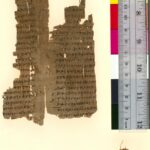| Artefact ID | 400 |
| TM ID | TM 59463 |
| Findspot (DEChriM ID) | 28 (al-Bahnasā) | Class | Textual |
| Material | Papyrus |
| Writing medium | Sheet/roll |
| Text content | Literary, Subliterary |
| Language | Greek |
| Description | P.Mich. XVIII 764; P.Mich. inv. 3689. Fragment from a papyrus roll containing an unknown work by Clemens Alexandrinus with quotes from the Bible, inter alia Matthew 3:12 (= Luke 3:17), Jeremias 18:3-6, and saint Paul (Corinthians 3:13). The quotations from Jeremias and Paul are highly periphrastic and full of omissions, thus indicating a context of homily or significant discourse; see Blumell / Wayment 2015: 291. The verso is blank. The text consists of parts of two columns with 26 (left column) and 24 (right column) partly preserved lines. The script is elegant, small and rounded, and gives a professional impression. Punctuation appears often and in a variety of points (low, mid, and dicola). The text also uses dipla in column II, l. 9, 20 and 21 to mark quotes from bible passages within the text. The text also employs marks of breathing and the dottet obolos in col. II l. 1 and 5, and there appears one nomen sacrum in variations throughout the surviving text (for κυριός "Lord" in col. I, l. 17 and col. II l.8). Blumell suggests that the text was used in an ecclesiastical context, perhaps containing as teachings for catechumens; Blumell / Wayment 2015: 291. |
| Selection criteria | Literary genre (Theological), Subliterary genre (Liturgical), Nomina sacra |
| Date from | 250 |
| Date to | 350 |
| Dating criteria | Palaeography. The ed. pr. dates the text to 2/3 c. by comparison with P.Bodmer II (Gospel of John, 200-250, Panopolis) and P.Oxy. XXV 2441 (Works by Pindar, 125-175, Oxyrhynchus). The most recent date assessment (placing the fragment between 250-350) was done by the palaeographer Pasquale Orsini in a letter. |
| Absolute/relative date | Relative date |
| Archaeological context | The fragment was purchased by Prof. Arthur Boak in 1925; see the report by H.I. Bell of May 2, 1925). Findspot and provenance are uncertain, but the fragment was described as coming from al-Bahnasā (Oxyrhynchus) |
| Accession number | Ann Arbor, Michigan University, Library P. 3689 |


 Json data
Json data




